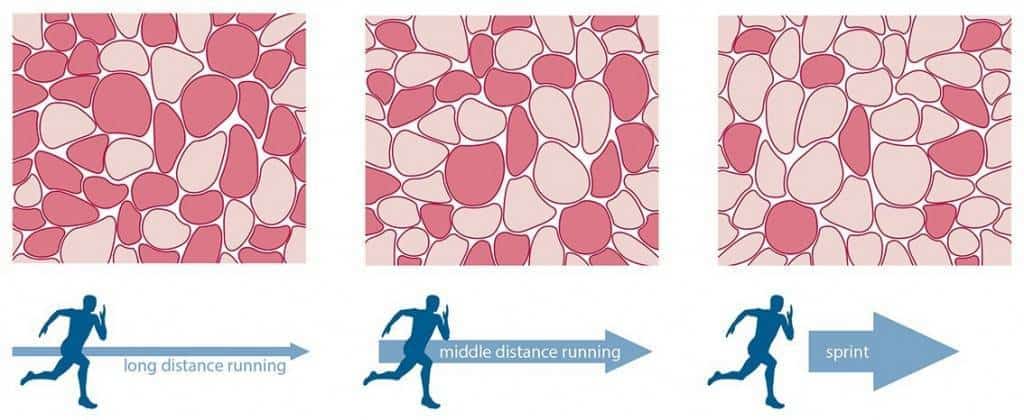There are essentially three muscle fiber types in human muscle:
Type I Fibers Color – Red Speed – Slow Energy – Aerobic
These fibers are fatigue-resistant. Red fibers are rich in capillaries and myoglobin (enhancing oxygen delivery) with an increased number of mitochondria which enhances the ability to oxidize fats. Muscles containing a predominant amount of slow twitch muscle fibers tend toward stabilizing functions rather than prime movers of muscle tissue. Individuals with a greater number of Type I fibers tend to excel in endurance related activities that last longer than 3 minutes. These are the fibers predominantly utilized in a triathlon.

Type IIa Fibers Color – Pink Speed – Moderate Energy – Aerobic and Anaerobic
These fibers have traits of both Type I and Type IIb. Individuals with a greater number or more conditioned Type IIa fibers tend to excel in activities lasting between 30 seconds and 2 minutes with a moderate level of strength and aerobic capacity capabilities. These fibers are often emphasized at the beginning and end of races. Type IIA fibers can become more endurance oriented like Type I fibers with the right exercise stress, but these fibers will never be powerful like Type IIB fibers.
Type IIb Fibers Color- White Speed – Fast Energy – Anaerobic
These fibers are larger in diameter and well suited for brief, powerful contractions. White fibers have little mitochondria and small capillary beds. These fibers tend to be prime movers of joints. Individuals with a greater number of Type IIb fibers tend to excel in highly explosive activities such as maximal lifts and sprinting or jumping. These are also the fibers that have the greatest potential for hypertrophy. These power fibers are not often emphasized in triathlons with the exception of the kick or occasional bursts of speed for passing other competitors.
What Are the Different Types of Muscle Actions?
Concentric
- Shortening of a muscle fiber as it resists against a load
- “Raises” the load
- “Accelerated” the load (such as the updward phase of a dumbbell bicep curl)
Eccentric
- Lengthening of a muscle fiber against a load
- “Lowers” the load
- “Decelerates” the load (such as the downward phase of a dumbbell bicep curl)
Isometric
- When a muscle neither lengthens nor shortens against a load (no net joint movement)
- A co-contraction of agonist and antagonist muscle
- “Stabilizes” the load (such as holding the elbow still at 90 degrees in a dumbbell bicep curl)
Isotonic
When a concentric and/or eccentric action is generated to move a load through a range of motion where the force on the muscle does not change (found in some machines)
Isokinetic
When the muscle action speed is held constant (found in special exercise equipment often used in a laboratory)
You will learn about muscle fiber types, muscle actions and how to train people based on these scientific facts in the NESTA Personal Fitness Trainer Certification, the MMA Conditioning Coach Certification and the ITCA Triathlon Coach Certification programs.





